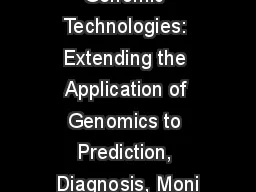

Detection Luis A Diaz MD Johns Hopkins Mutations are highly specific Cancer Cell Normal Cells PreCancer Cell Mutations No Mutations Access to Somatic Mutations Tumor Tissue FFPE Frozen tissue ID: 775100
Download Presentation The PPT/PDF document " Emerging Genomic Technologies: Extendin..." is the property of its rightful owner. Permission is granted to download and print the materials on this web site for personal, non-commercial use only, and to display it on your personal computer provided you do not modify the materials and that you retain all copyright notices contained in the materials. By downloading content from our website, you accept the terms of this agreement.
Slide1
Emerging Genomic Technologies: Extending the Application of Genomics to Prediction, Diagnosis, Monitoring, and Early
Detection
Luis A. Diaz, M.D.
Johns Hopkins
Slide2Slide3Mutations are highly specific
Cancer Cell
Normal Cells
Pre-Cancer Cell
Mutations
No Mutations
Slide4Access to Somatic Mutations
Tumor Tissue
FFPE
Frozen tissue
Blood & other bodily fluids
Cell-free DNA
Circulating tumor cells (CTCs)
Slide5Technology to assess circulating tumor DNA
Digital PCR
Best for individual point mutations but can be used for crude copy number analysis
Mutation needs to known ahead of time (
ie
BRAF v600e)
Sensitivity is dependent on specific mutation and assay optimization
Multiplexing assay is possible
Fast and highly reproducible – results in hours
Minimal bioinformatics needs
Inexpensive
Next-generation Sequencing
Evaluates genomic regions of interest using PCR or capture-based methods
Has been used for point mutations, rearrangements, genomic amplification, aneuploidy, whole
exome
and whole genome sequencing
High false discovery rate that requires pre-sequencing barcoding and post-sequencing bioinformatics for error suppression
Expensive
Turnaround time 1-2 days at best
Slide6Prevention
Applications of
ctDNA
Slide7Applications of ctDNA
G
enotyping cancer & identify actionable genetic alterations
For patients lack tissue for molecular analysis
For patients whose tumors have evolved over time and treatment (too risky to perform or after relapse when biopsies are not routine)
Discordance between mutations in primary/metastases lesions
Acquired resistance (e.g., patients who develop resistance to EGFR blockade)
Monitoring of tumor burden / response to treatment (vs. CEA or imaging)
Detection of Occult Disease
Minimal Residual Disease
Early Detection/Screening
Slide8What is Minimal Residual Disease (MRD)?
Cured
Not
Cured
Minimal Residual Disease
None
Present
Definitive Therapy
(potentially curative)
Chemotherapy
Surgery
Radiation
Slide9Molecular Analysis
Frank
Diehl
Kerstin
Schmidt
Slide10Before Surgery
Day 0
After Surgery Day 1
After Surgery Day 42
CT scan negative
After Surgery Day 244
CT scan positive
13.4 %
0.015 %
0.11 %
0.66 %
Percent Mutant APC
Wild-type fragments
Mutant fragments
Diehl et al Nature Medicine, 2008
Slide1111
J. Tie and Peter Gibbs,
ASCO 2015
MRD detection with
ctDNA
in
stage II CRC
Slide12MRD detection with ctDNA in breast cancer.
Isaac Garcia-Murillas et al., Sci Transl Med 2015;7:302ra133
Published by AAAS
Slide13Future for ctDNA
Incremental improvements in technology
Increase in comprehensive panels
Limited by biology more that technology
Need a biologic based discovery to drive dramatic improvement
Clinical Application
Tumor genotyping in plasma will be integrate into routine practice – based on concordance studies
High impact applications that drive improvements in OS will require prospective clinical trials and partnership with FDA.
Slide14Challenges for Implementation
Demonstrating Clinical Value
How do we judge value?
Lack of focus on end-points that influence outcome
.
Limitations of Technology
Cost
Complexity
Lack of standardization
Quality
Knowledge Gap
Medical Community
Payers
Regulatory bodies (innocent bystanders)
Slide15Prevention
Applications of
ctDNA
Slide16Recommendations
Simple comprehensive cancer genotyping needs to be reimbursed at a level that can be performed optimal QUALITY
Research needs to be differentiated from clinical care
Quality needs to be defined by expert groups (i.e. AMP, AACR)
Slide17Recommendations
Payers need to reimburse based on value (i.e. ALK is more valuable than KRAS OR minimal residual disease testing is more valuable than simple genotyping
)
High value biomarker = Drug (from everyone’s perspective
)
A need for a sub specialty that can take on complexity of current and emerging biomarkers with expertise in clinical oncology
.